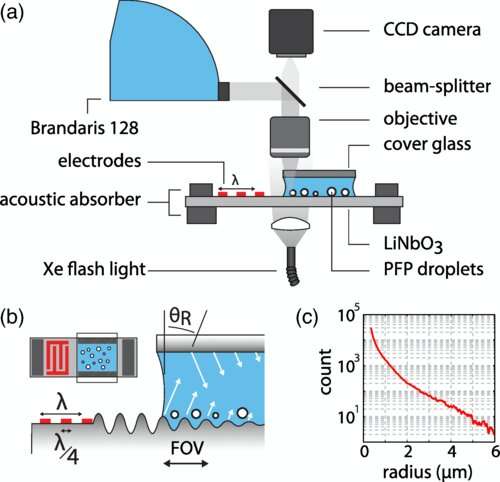Vibrating nanodroplets may invade a tumor

Sending tiny droplets to a tumor and having them vaporized using focused ultrasound: It could be a new way of tracing a tumor or deliver drugs locally. Researchers of the University of Twente now demonstrate a new phenomenon triggering droplet vaporization: It happens at the exact acoustic resonance frequency and causes fast and efficient lowering of the pressure inside the droplet, until below the threshold value for vaporization. The research results are published in Physical Review Letters.
Micro droplets, stabilized using a thin shell, can be visualized in the blood stream using ultrasound. They have a growing number of medical applications in imaging and therapy. The droplets, however, are too large to invade a tumor. Smaller nanoscale droplets can do this. By guiding them to the tumor and vaporizing them on the spot, the resulting bubbles can have a therapeutic effect inside the tumor. Vaporization may typically seem a physical phenomenon of which everything is known already, but the UT researchers now demonstrate a new mechanism based on resonance, as in the case of crystal glass breaks caused by the sound of a specific singing note. It is at the resonance frequency that vaporization can be guided and amplified. The research was done using droplets of hydrofluorocarbons (HFCs), with a low boiling point.
In practice, vaporization is hard to control, as nucleation points are needed. These are the triggers for vaporization. The drastic lowering of pressure taking place at resonance—six times lower than in the surrounding fluid—causes a dramatically higher vaporization probability. The resonance effect is caused by the difference in the speed of sound—inside the fluorocarbon, it is much lower than in the water or tissue surrounding it.
The right moment
By sending an acoustic wave to the droplets, the researchers demonstrate how vaporization is triggered. This highly controlled vaporization may introduce new ways of treating tumors. Imagine switching the vaporization on, the moment the droplet has invaded the tumor: This can damage the tumor caused by the violent vaporization process. It can also be a used for delivering drugs in the tumor locally and exclusively, without side effects in the rest of the body.
Besides medical applications, the new insights into resonance-guided vaporization could be important in energy storage or combustion processes.
The paper, "High-frequency acoustic droplet vaporization is initiated by resonance," by Guillaume Lajoinie, Tim Segers and Michel Versluis, was published in Physical Review Letters.
More information: Guillaume Lajoinie et al. High-Frequency Acoustic Droplet Vaporization is Initiated by Resonance, Physical Review Letters (2021). DOI: 10.1103/PhysRevLett.126.034501
Journal information: Physical Review Letters
Provided by University of Twente





















